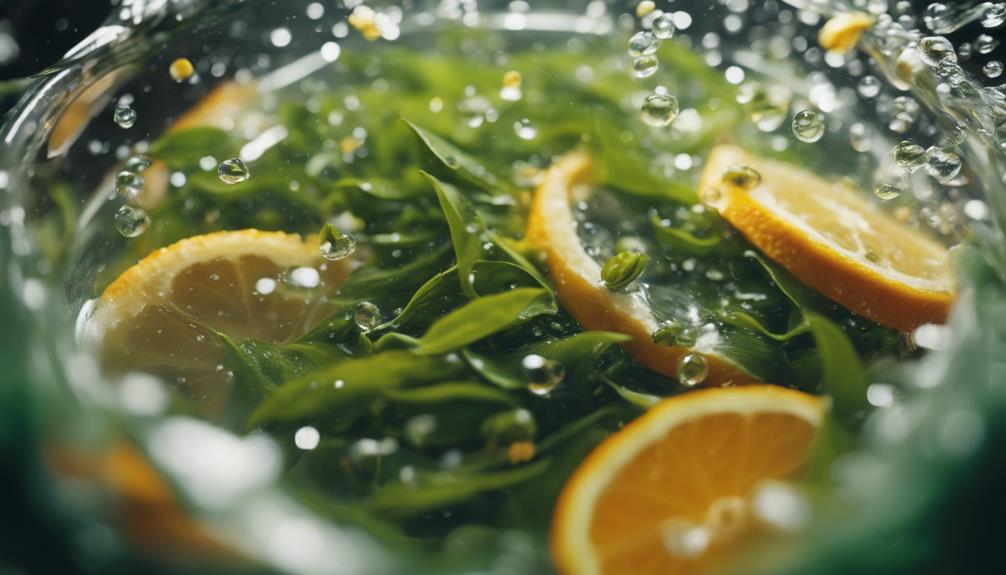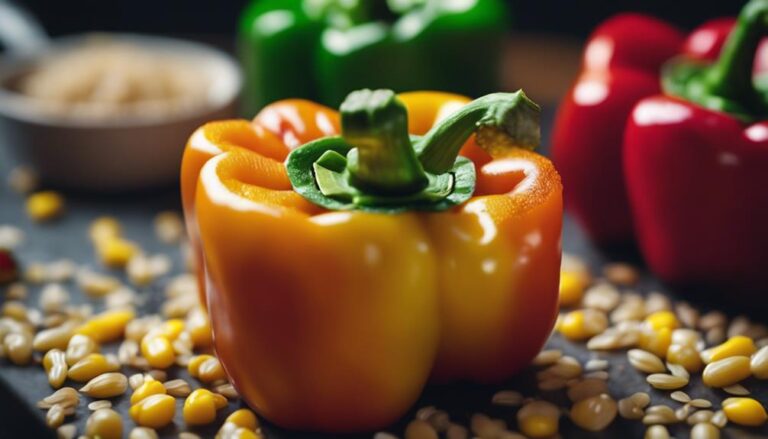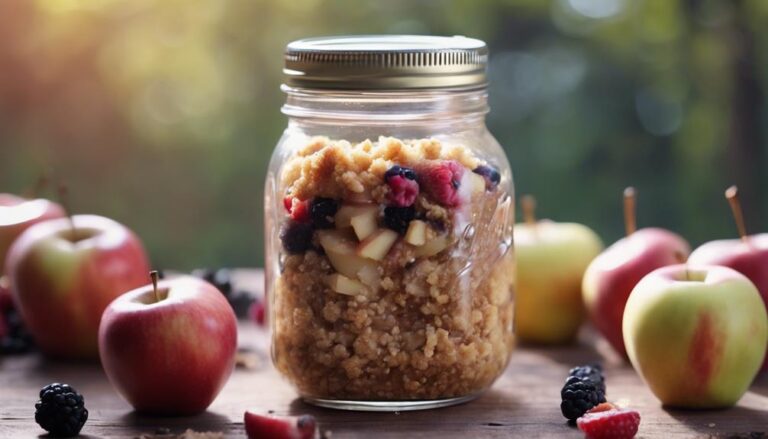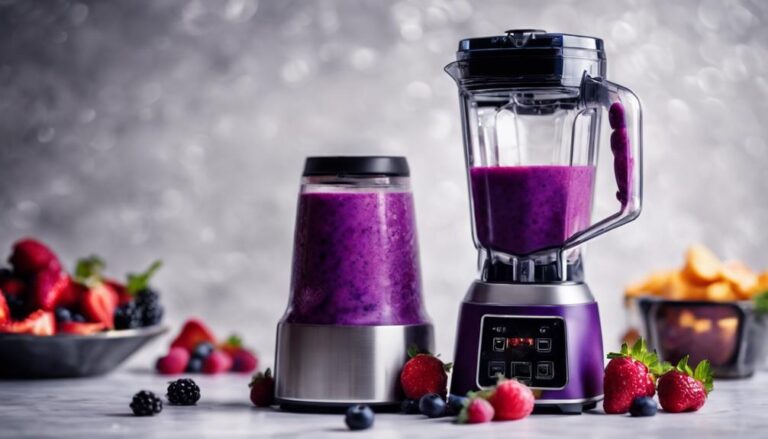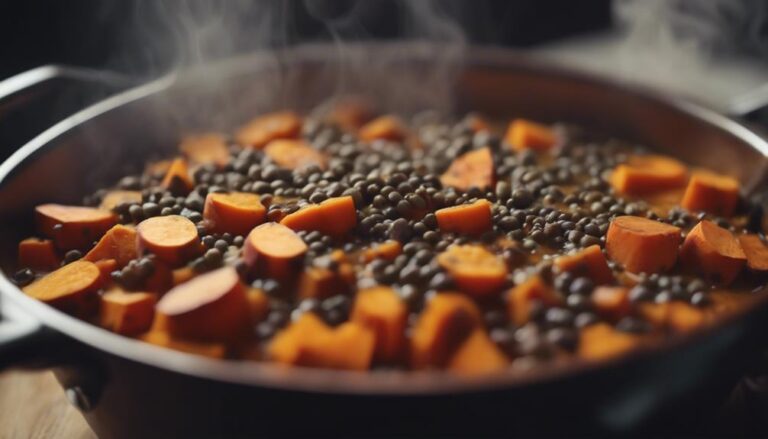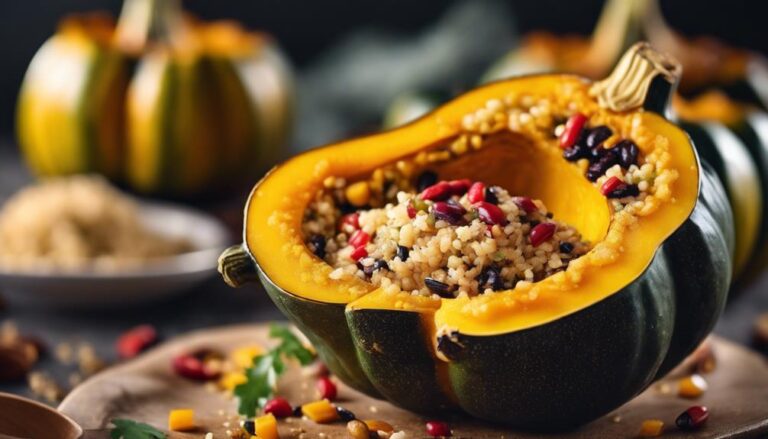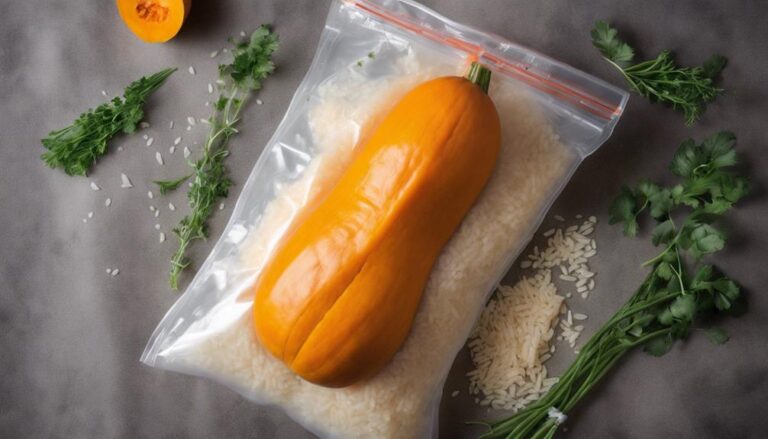Sous Vide Green Tea Infusion With Citrus
Enhance your tea experience with sous vide green tea infusion with citrus. Achieve a vibrant fusion of flavors and boost antioxidant content. Enjoy the delicate balance that tempers green tea bitterness while creating a customizable flavor profile. Elevate your tea game with this delightful blend.
What You Will Learn Here
- Sous vide method enhances green tea flavor with precise temperature control.
- Citrus infusion adds vibrant, refreshing notes to green tea.
- Sous vide ensures optimal extraction of green tea's antioxidants.
- Citrus balances green tea's bitterness for a harmonious blend.
- Unique fusion creates a customizable, citrusy green tea experience.
Tea Infusion Origins
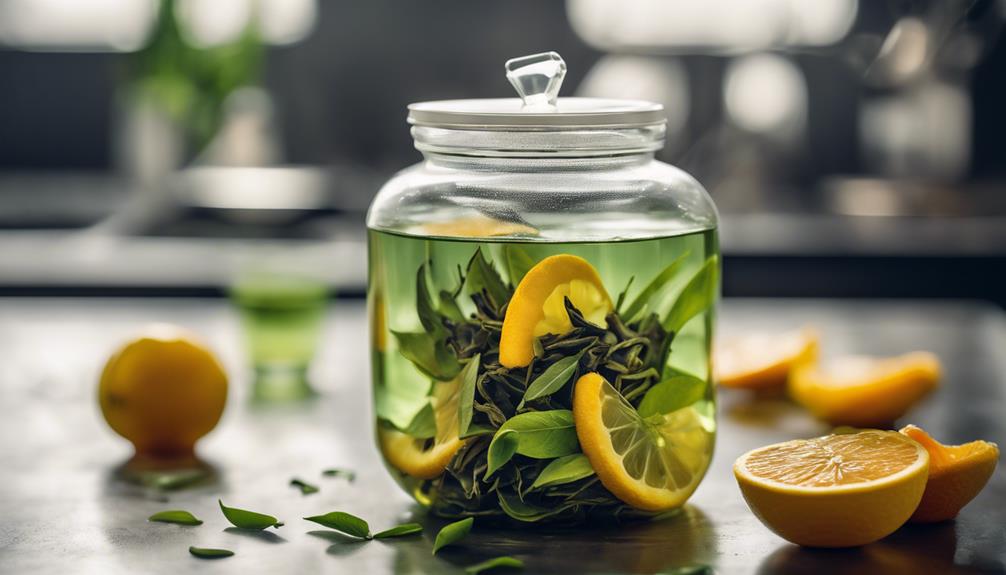
Tea infusion has a rich history dating back to ancient China, where the practice first emerged around 2737 BC.
The origins of tea infusion are rooted in the simple yet effective method of steeping tea leaves in hot water to extract their flavors and beneficial compounds.
Over time, various infusion techniques have been developed, showcasing the evolution and innovation in the art of tea infusion.
Tea Infusion History
Originating in ancient China, the practice of tea infusion has evolved from its medicinal roots into a rich cultural tradition emphasizing precise techniques for flavor extraction. Chinese tea masters honed the craft, focusing on factors like temperature, brewing time, and water quality to extract the best flavors. This tradition spread throughout Asia and globally, with each region adding its unique twist to tea infusion methods. Different types of tea demand specific infusion techniques to highlight their distinct characteristics, contributing to the diverse world of tea culture. Modern technology, such as sous vide, has revolutionized tea infusion, allowing for precise control and innovative blends.
| Tea Infusion History | Key Points |
|---|---|
| Ancient China | Medicinal roots |
| Cultural Tradition | Precise techniques |
| Global Influence | Diverse tea culture |
Origins of Tea
Emerging from ancient China's rich history of medicinal discoveries, the roots of tea can be traced back to Emperor Shen Nong's era around 2737 BC. Initially valued for its health benefits, tea gradually transformed into a beloved beverage cherished for its taste and fragrance.
As you explore the world of tea, feel free to investigate its diverse origins and cultivation techniques. Tips and tricks abound when it comes to brewing the perfect cup, so don't hesitate to experiment with different varieties and infusion methods.
From the rolling hills of Japan to the lush plantations of India, each region offers a unique tea experience waiting to be savored. Embrace the freedom to discover the rich tapestry of flavors that tea has to offer.
Infusion Techniques
With a history steeped in ancient traditions, the practice of infusion techniques for beverages like tea has undergone significant evolution over time. Tea infusion originated centuries ago in China and Japan, where the simple method of steeping tea leaves in hot water was used to extract flavor and aroma. Today, infusion techniques have seen remarkable innovations like sous vide, enabling precise temperature control and flavor extraction. This infusion innovation allows for the enhancement of tea flavors by incorporating ingredients such as citrus fruits. The combination of sous vide technology and tea infusion offers a unique approach to creating infused beverages that cater to modern preferences for controlled infusion processes.
| Infusion Techniques | Description |
|---|---|
| Temperature control | Enables precise heat regulation for optimal flavor extraction. |
| Flavor extraction | Involves extracting the essence and taste from tea leaves. |
| Infusion innovation | Incorporates modern methods like sous vide for enhanced infusion processes. |
Tea Varieties for Infusion
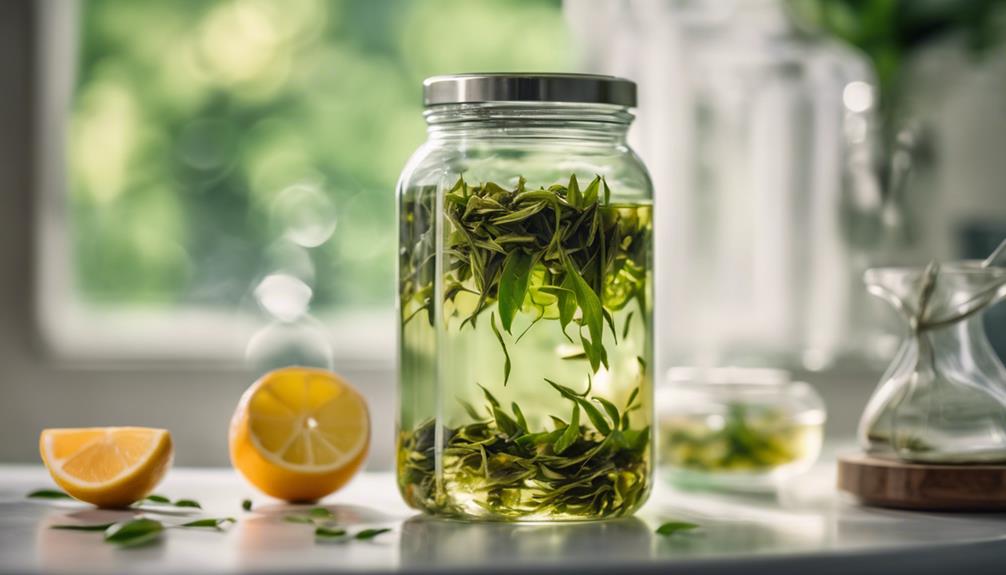
Green tea varieties suitable for infusion in sous vide preparations include sencha, matcha, and genmaicha due to their distinct flavors and antioxidant properties.
- Sencha green tea offers a grassy and slightly sweet flavor profile, perfect for infusing with citrus fruits in sous vide.
- Matcha green tea, known for its vibrant green color and earthy taste, can add depth to citrus-infused water when used in sous vide infusions.
- Genmaicha, a blend of green tea and roasted brown rice, provides a nutty and toasty flavor that complements citrus notes in sous vide infusions.
- Different green tea varieties offer unique characteristics that can elevate the flavor profile of citrus-infused water in sous vide preparations.
Each of these green teas brings its own unique essence to the infusion process. Sencha, with its grassy notes, is ideal for pairing with floral infusions. Matcha's earthy tones can enhance herbal tea blends, while genmaicha's nutty flavor profile pairs beautifully with fruit infusions. Experimenting with these varieties can lead to exciting and delicious results in sous vide green tea infusions.
Unique Infusion Combinations
Consider exploring the intriguing fusion of flavors with a Citrus-Infused Green Tea Recipe, a Matcha Green Tea Latte, or a Mint-Infused Green Tea Sorbet. These unique infusion combinations can offer a delightful twist to your tea experience, blending diverse ingredients to create harmonious and interesting taste profiles.
Experimenting with unconventional pairings like these can lead to discovering invigorating and innovative ways to enjoy green tea.
Citrus-Infused Green Tea Recipe
For an invigorating twist on traditional green tea, infuse it with a medley of citrus fruits to create a vibrant and zesty flavor profile. Citrus-infused green tea combines the antioxidant benefits of green tea with the revitalizing tang of citrus fruits, enhancing its flavor profile.
Experimenting with different citrus fruits like lemon, lime, and orange can lead to a variety of flavor combinations in green tea infusions. The bright and citrusy aroma of these fruits adds an extra dimension to the green tea infusion, offering a unique and rejuvenating experience for your taste buds.
The citrus pairing not only elevates the taste but also provides infusion benefits that can enhance your overall well-being.
Matcha Green Tea Latte
To explore unique infusion combinations with Matcha Green Tea Latte, consider incorporating citrus elements like lemon or orange for a revitalizing twist on this popular beverage. Matcha latte variations can offer a rejuvenating change to your usual drink choices.
Incorporating citrus into your matcha latte can enhance the flavor profile and add a burst of freshness. Health benefits of matcha green tea include its high antioxidant content and the combination of caffeine for energy and L-theanine for a calming effect.
When brewing a matcha latte, make sure the water temperature is around 175°F to avoid scalding the tea leaves and to preserve the delicate flavors. Experiment with different citrus fruits and ratios to find the perfect balance that suits your taste preferences.
Mint-Infused Green Tea Sorbet
Infusing mint into green tea sorbet elevates its flavor profile with a revitalizing and harmonious blend, offering a rejuvenating and harmonious dessert option.
- Sorbet Variations:
Mint-infused green tea sorbet provides a unique twist on traditional sorbet flavors, adding a revitalizing and cooling element.
- Health Benefits:
Mint is known for its digestive properties, potentially making this sorbet a soothing treat for the stomach.
- Serving Suggestions:
This sorbet can serve as a palate cleanser between courses or as a light and healthy dessert option to end a meal.
Tea Brewing Techniques
To master tea brewing techniques effectively, you should focus on the basics of tea steeping. Understanding the importance of water temperature and adjusting steeping time according to the tea type are crucial steps. By following these fundamental steps, you can enhance the flavors and aromas of green tea, ensuring a delightful and well-balanced brew every time.
Experimenting with different brewing methods and variables can help you tailor your tea experience to your preferences. It also allows you to explore the intricacies of this ancient beverage.
Tea Steeping Basics
Steeping green tea in water extracts its flavors and beneficial compounds, a process essential for achieving a balanced flavor profile and maximizing health benefits. When preparing herbal tea, such as green tea, consider the delicate floral notes and aromatic blends that emerge during the steeping process.
To avoid bitterness, steep green tea for 3-4 minutes, as over-extraction can lead to an unpleasant taste. Understanding the importance of water temperature is key; green tea thrives at lower temperatures around 175-180°F.
Water Temperature Importance
Maintaining the appropriate water temperature while brewing green tea greatly impacts the flavor extraction and overall taste of the infusion. Temperature control is essential to achieve a well-balanced infusion. Using water that is too hot can lead to bitterness, while water that is too cold may result in a weak flavor. Here is a table highlighting the importance of water temperature in green tea brewing:
| Water Temperature | Effect on Infusion |
|---|---|
| Too Hot (above 185°F) | Bitter and astringent taste |
| Ideal (175-185°F) | Balanced infusion with full flavor |
| Too Cold (below 175°F) | Weak infusion with limited flavor intensity |
Maintaining the correct water temperature throughout the brewing process ensures a harmonious infusion balance and enhances the overall flavor extraction.
Steeping Time Variation
For essential flavor extraction and balance, varying the steeping time is a key factor in enhancing green tea infusion techniques. Steeping green tea for 3-4 minutes can prevent bitterness and achieve a balanced flavor profile, while longer times result in a stronger taste and shorter times yield a milder infusion.
Different tea grades may require specific steeping times for best flavors. Adjusting steeping times allows for flavor customization to match personal preferences. Proper steeping time variation is vital for achieving the desired strength and taste in green tea-infused water.
Final Thoughts
In conclusion, the fusion of green tea and citrus through sous vide encapsulates a harmonious blend of antioxidants and vibrant flavors. This method not only enhances the antioxidant properties of green tea but also infuses it with the zesty and invigorating notes of citrus fruits. The controlled temperature of sous vide guarantees that the flavors are extracted precisely, resulting in a well-balanced infusion.
Here is a breakdown of the benefits of this fusion:
| Citrus Pairing | Flavor Profiles | Infusion Benefits |
|---|---|---|
| Enhances citrusy notes in green tea | Creates a invigorating and vibrant taste | Boosts antioxidant content in the infusion |
| Adds a zesty twist to the earthy green tea | Balances out the bitterness of green tea | Provides a customizable flavor profile |
| Complements the grassy undertones of green tea | Brings a hint of sweetness to the infusion | Enhances the overall aroma of the infusion |
Frequently Asked Questions
What Temperature Do You Sous Vide Tea At?
When brewing tea, control temperature for best flavor extraction. Maintain precision at 130-140°F to preserve delicate flavors. Avoid high temps over 160°F to prevent bitterness. Use sous vide for consistent results.
What Temperature Do You Infuse Sous Vide?
When infusing sous vide, maintain precise temperature control to enhance herbal infusions. Peak flavor extraction occurs at specific temperatures. Your task is to master temperature control for consistent results and superior flavor in your infusions.
What Temperature Do You Infuse Alcohol in Sous Vide?
When infusing alcohol in sous vide, maintain precise temperatures between 135°F to 160°F for best flavor extraction. Different liquors demand specific ranges; vodka at 135°F, bourbon at 160°F. Guarantee temperature control to preserve alcohol properties.
What Temperature Do You Sous Vide Syrups?
When sous vide syrups, maintain ideal temperatures between 135°F to 160°F for best infusion. Precise temperature control extracts syrup flavors effectively. Experiment with citrus pairings and infusion techniques. Sealed containers prevent evaporation, preserving aromas.
Conclusion
To sum up, sous vide green tea infusion with citrus offers a unique and flavorful twist to traditional tea brewing methods. By using precise temperature control and extended steeping times, this technique allows for a more intense infusion of flavors without the risk of bitterness.
Experimenting with different tea varieties and citrus fruits can result in endless possibilities for creating your own custom tea blends. Embrace the art of tea infusion and elevate your tea experience with this innovative method.
